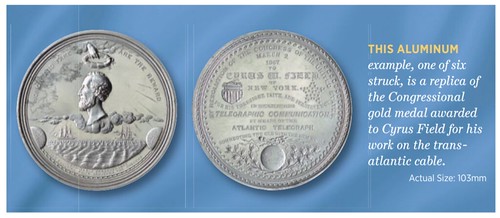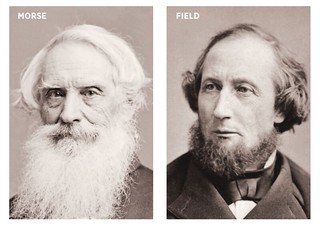
PREV ARTICLE
NEXT ARTICLE
FULL ISSUE
PREV FULL ISSUE
THE 1868 CYRUS FIELD CONGRESSIONAL GOLD MEDALAs a student of the history of business and technology, I enjoyed reading an article about the Cyrus Field medal by American Numismatic Association Museum Curator Doug Mudd in
the December 2017 issue of The Numismatist, the ANA's monthly publication. With permission, here is a lengthy excerpt. -Editor
More recently, as I was researching the use of Morse code (a set of audible signals that represent the letters in the alphabet) for the ANA’s World War I exhibit, I remembered this medal for its connection to the early telegraph. The piece in question is the Congressional Medal honoring the achievements of Cyrus W. Field and was struck by the U.S. Mint to commemorate the laying of the first permanent transatlantic cable for telegraphic communication. Samuel F.B. Morse, an artist turned-inventor, conceived the idea for the electric telegraph in 1832, around the same time that several European inventors proposed a similar concept. Morse, working independently, built a functioning telegraph in the mid- 1830s, followed in the late 1830s by his invention of Morse code. Morse opened the world’s first commercial telegraph line with the message “What hath God wrought,” sent in Morse code from the U.S. Capitol to a railroad station in Baltimore in 1844. Within a decade, more than 20,000 miles of telegraph cable crisscrossed the country. Mostly unknown today, Cyrus West Field (1819-92) was an American entrepreneur who made a fortune as a businessman and financier. In 1854 he focused his energy on his new passion: connecting America and Europe by telegraph. Field secured a charter to lay an insulated telegraph line across the Atlantic Ocean and joined several investors and engineers, including Samuel Morse, to begin work on the project. Known as the “Cable Cabinet,” the group was responsible for connecting St. John’s, Newfoundland, with Nova Scotia. With this experience under his belt, Field went on to form the American Telegraph Company in 1855, which soon became one of the world’s largest telegraph agencies, second only to Western Union.  In 1857 the Atlantic Telegraph Company, with backing from the United States and Great Britain, began laying the first transatlantic cable. On August 16, U.S. President James Buchanan and Great Britain’s Queen Victoria exchanged messages, officially initiating nearly instantaneous communication across the Atlantic. Unfortunately, the cable was not strong enough to withstand the strain, and the current it carried was too weak for clear and consistent transmission. By the beginning of September, it had failed completely. Field made three more unsuccessful attempts over the next few years. On his fifth try, this time with the AngloAmerican Telegraph Company and more durable equipment, he finally succeeded in laying the first permanent cable across the Atlantic Ocean in 1866. The 1,852 miles of cable were laid using the largest sailing steamship of the time, the S.S. Great Eastern. Field became an instant worldwide celebrity and received honors and recognition from many nations and scientific societies—and he made a massive profit. In 1867 he was awarded a Congressional gold medal and the grand prize at the International Exposition in Paris for his work. Field later promoted other oceanic cables, including telegraph lines that stretched from Hawaii to Asia and Australia. Subsequently, he became involved in several successful business ventures and western railroads, but ultimately his luck ran out, and he went bankrupt in 1887. Field died on July 2, 1892, in New York City. The medal itself has a history nearly as interesting as its subject. Issued in gold (2 pieces), aluminum (6 known) and bronze (128), the 103mm medal was designed by Joseph Goldsborough Bruff, supervising architect of the Treasury Department. William Barber, an assistant engraver at the time, was tasked with executing the piece, which he completed in early 1868. The mint later produced 76mm restrikes in the 20th century. The obverse depicts a bust of Cyrus W. Field facing left with a hand coming down from the heavens and placing a laurel crown on his head. Below him are ships laying the transatlantic cable from one hemisphere, marked AMERICA, to the other, EUROPE. The inscription reads, HONOR AND FAME ARE THE REWARD/INDOMITABLE PERSEVERANCE/AND ENDURING FAITH ACHIEVED THE SUCCESS. On the reverse, oak and laurel branches surround a globe surmounted by lightning that zigzags behind a torch placed over a caduceus. An American shield is on the left, and a star composed of smaller stars is to the right of the legend, which reads BY THE RESOLUTION OF THE CONGRESS OF THE UNITED STATES, /MARCH 2,/1867./TO/CYRUS W. FIELD /OF/NEW YORK/FOR HIS FORESIGHT, FAITH, AND PERSISTENCY,/IN ESTABLISHING/TELEGRAPHIC COMMUNICATION,/BY MEANS OF THE/ ATLANTIC TELEGRAPH,/CONNECTING THE OLD WITH THE NEW WORLD. For more information on the American Numismatic Association, see:  Wayne Homren, Editor The Numismatic Bibliomania Society is a non-profit organization promoting numismatic literature. See our web site at coinbooks.org. To submit items for publication in The E-Sylum, write to the Editor at this address: whomren@gmail.com To subscribe go to: https://my.binhost.com/lists/listinfo/esylum All Rights Reserved. NBS Home Page Contact the NBS webmaster 
|
